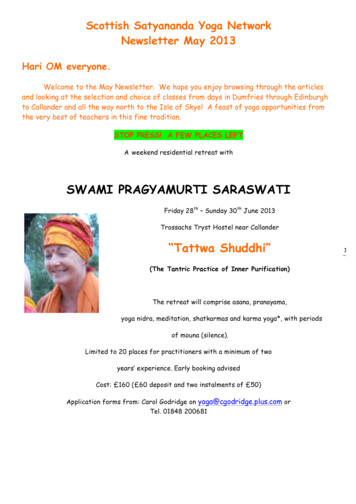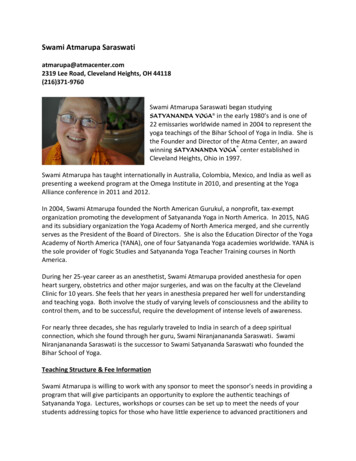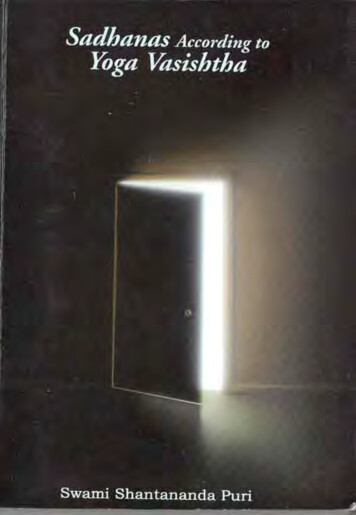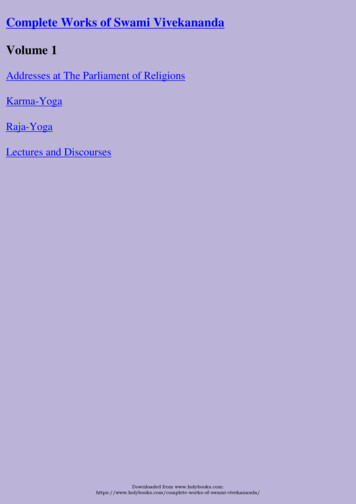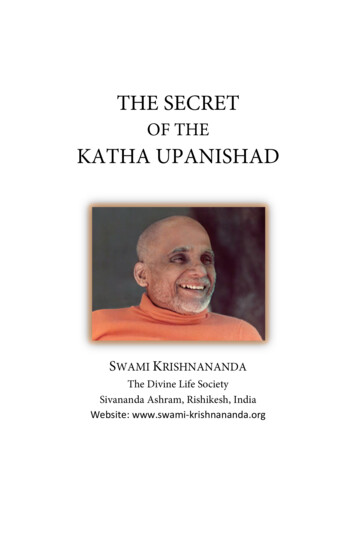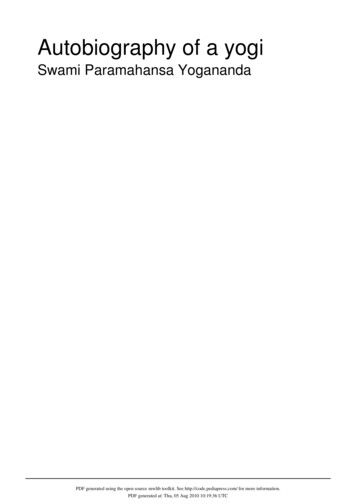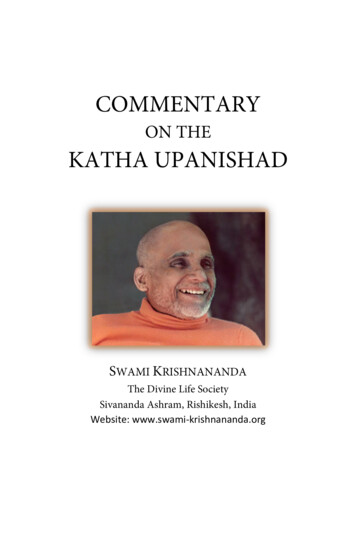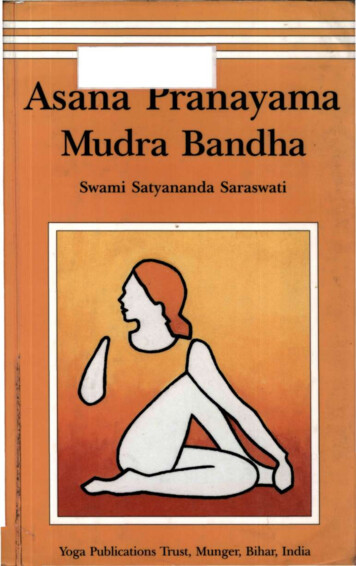
Transcription
SATYANANDA YOGABIHAR YOGAAsana Pranayama Mudra Bandha is recognised internationallyas one of the most systematic yoga manuals available today.Since its first publication by the Bihar School of Yoga in 1969,it has been reprinted thirteen times and translated into manylanguages. It is the main reference text used by yoga teachersand students of Bihar Yoga/Satyananda Yoga within theInternational Yoga Fellowship Movement, and many othertraditions as well.This comprehensive t e x t provides clear illustrations, step bystep directions and details of chakra awareness. It guides thepractitioner or teacher f r o m the simplest to the most advancedpractices of the hatha yoga system. A therapeutic index isincluded for use by doctors and yoga therapists incorporatingrecent information f r o m research into yoga. This editionsuccessfully brings the exposition of yoga practices to thestandard of a university text.Price: Indian Rs. 175/-
Asana PranayamaMudra BandhaSwami Satyananda SaraswatiYoga Publications Trust, Munger, Bihar, India
Bihar School of Yoga 1996All rights reserved. No part of this publication may be reproduced,transmitted or stored in a retrieval system, in any form or by any means,without permission in writing from Yoga Publications Trust.Printed by Bihar School of YogaFirst published 1969Reprinted 1971Second edition 1973Reprinted 1977, 1980, 1983, 1989, 1993, 1995, 1996Third revised edition 1996 (by Bihar Yoga Bharati withpermission of Bihar School of Yoga)Reprinted 1997,1999Printed by Yoga Publications TrustReprinted 2002ISBN: 81-86336-14-1Price: Indian rupees one hundred and seventy five onlyPublisher and distributor: Yoga Publications Trust, Ganga Darshan,Munger, Bihar, India.Website: www.yogavision.netE-mail: ypt@yogavision.netPrinted at Thomson Press (India) Limited, New Delhi, 110001
SWAMI SIVANANDA SARASWATISwami Sivananda was born at Pattamadai, Tamil Nadu, in 1887. Afterserving as a medical doctor in Malaya,he renounced his practice, went toRishikesh and was initiated into Dashnami sannyasa in 1924 by SwamiVishwananda Saraswati. He touredextensively throughout India, inspiringpeople to practise yoga and lead adivine life. He founded the Divine LifeSociety at Rishikesh in 1936, theSivananda Ayurvedic Pharmacy in 1945, the Yoga Vedanta ForestAcademy in 1948 and the Sivananda Eye Hospital in 1957. Duringhis lifetime Swami Sivananda guided thousands of disciples andaspirants all over the world and authored over 200 books.SWAMI SATYANANDA SARASWATISwami Satyananda was born at Almora,Uttar Pradesh, in 1923. In 1943 he metSwami Sivananda in Rishikesh andadopted the Dashnami sannyasa wayof life. In 1955 he left his guru's ashramto live as a wandering mendicant andlater founded the International YogaFellowship in 1963 and the Bihar Schoolof Yoga in 1964. Over the next 20 yearsSwami Satyananda toured internationally and authored over 80 books. In1987 he founded Sivananda Math, a charitable institution for aidingrural development, and the Yoga Research Foundation. In 1988 herenounced his mission, adopting kshetra sannyasa, and now livesas a paramahamsa sannyasin.
SWAMINIRANIANANANDASARASWATISwami Niranjanananda was born atRajnandgaon, Madhya Pradesh, in 1960.At the age of four he joined the BiharSchool of Yoga and was initiated intoDashnami sannyasa at the age of ten.From 1971 he travelled overseas andtoured many countries for the next 11years. In 1983 he was recalled to Indiaand appointed President of Bihar Schoolof Yoga. During the following 11 yearshe guided the development of GangaDarshan, Sivananda Math and the Yoga Research Foundation. In1990 he was initiated as a paramahamsa and in 1993 anointedpreceptor in succession to Swami Satyananda. Bihar Yoga Bharatiwas founded under his direction in 1994. He has authored over 20books and guides national and international yoga programs.SWAMISATYASANGANANDA SARASWATISwami Satyasangananda (Satsangi) wasborn on 24th March 1953, in Chandorenagore, West Bengal. From the ageof 22 she experienced a series of innerawakenings which led her to her guru,Swami Satyananda. From 1981 she travelled ceaselessly with her guru in Indiaand overseas and developed into ascholar with deep insight into the yogicand tantric traditions as well as modernsciences and philosophies. She is an efficient channel for the transmission of her guru's teachings. Theestablishment of Sivananda Math in Rikhia is her creation andmission, and she guides all its activities there, working tirelessly touplift the weaker and underprivileged areas. She embodies compassion with clear reason and is the foundation of her guru's vision.
ContentsPrefaceIntroduction to Yogaxi1AsanaIntroduction to YogasanaBeginners GroupPawanmuktasana SeriesPart 1: Anti-rheumatic GroupPart 2: Digestive/Abdominal GroupPart 3: Shakti Bandha AsanasYoga Exercises for the EyesRelaxation AsanasMeditation AsanasVajrasana Group of AsanasStanding AsanasSurya NamaskaraChandra Namaskara91921234560748593108135159173Intermediate GroupPadmasana Group of AsanasBackward Bending AsanasForward Bending AsanasSpinal Twisting AsanasInverted AsanasBalancing Asanas179181194227250258290Advanced Group223Pranayama361BandhaMudraShatkarmaPsychic Physiology of YogaTherapeutic IndexIndex of Practices405421473513525545vii
Mudra
PrefaceThe first edition of Asana Pranayama Mudra Bandha, published in 1969, was derived from the direct teaching of SwamiSatyananda Saraswati during the nine month Teachers' Training Course conducted by him at Bihar School of Yoga, Mungerin 1969.The second edition was published in 1973 to commemoratethe Golden Jubilee of Swami Satyananda Saraswati. At thistime, the text was completely revised and new material addedfrom class notes taken during the 1970-71 Sannyasa TrainingCourse, which was the last course to be personally conductedby him.In response to popular demand and to meet the requirements of a university text, APMB was totally revised andupdated under the direction and inspiration of SwamiNiranjanananda Saraswati, the successor of Swami SatyanandaSaraswati. This enlarged edition was first published by BiharYoga Bharati in 1996, with the permission of Bihar School ofYoga, and is now being reprinted by Bihar School of Yoga.This text is currently being used as the main practical textfor the teaching of asana, pranayama, mudra, bandha andshatkarma within the Certificate and Diploma Courses in YogicStudies at Bihar Yoga Bharati. It is also a primary referencefor the postgraduate MA/MSc Courses in Yoga Psychology,Yoga Philosophy and Applied Yogic Science.Since publication of the first edition, interest in yoga hasspread widely. Now APMB is used in ashrams, centres andyoga schools in every country as the standard textbook forteachers and students alike. The techniques presented havexi
been assimilated by fields as diverse as medicine, education,entertainment, business and sport.The science of yoga applies itself to all aspects of life.Obviously, a subject of this breadth cannot be encapsulated inone volume. This revised edition presents basic yogic practicesincluding asanas, postures; pranayamas, breathing techniques;mudras, positions or gestures which represent the psyche;bandhas, locks for channelling energy; and shatkarmas, cleansingpractices. All of these techniques purify the body, mind andenergy systems to prepare the ground for higher practices ofmeditation and for the ultimate experience of cosmicconsciousness. Also included is a section introducing the chakras,psychic centres, and other aspects of the subtle body.The effects of yogic practices during and after performanceare currently being researched by scientists and doctors aroundthe world. Their results show that asanas, pranayamas, mudrasand bandhas are a potent means to restore and maintainphysical and mental health. In the near future we hope to seean increasing application of yoga in all walks of life.Asana Pranayama Mudra Bandha is designed for yogastudents, spiritual seekers and for those studying yoga indepth. Although many health professionals consult this textas a guide when constructing programs to provide clientswith physical, mental and emotional balance, these techniquesare not primarily for the sick but for the healthy.When learning the practices of yoga, the guidance of aqualified yoga teacher is recommended. This text providesyogic practices and information for personal evolution. Whenpractised faithfully, under the guidance of a competentteacher, these techniques will expand your consciousness.xii
Introduction to Yoga"Yoga is not an ancient myth buried in oblivion. It is the mostvaluable inheritance of the present. It is the essential need of todayand the culture of tomorrow."Swami Satyananda SaraswatiYoga is the science of right living and, as such, is intended tobe incorporated in daily life. It works on all aspects of theperson: the physical, vital, mental, emotional, psychic andspiritual.The word yoga means 'unity' or 'oneness' and is derivedfrom the Sanskrit word yuj which means 'to join'. This unity orjoining is described in spiritual terms as the union of theindividual consciousness with the universal consciousness. Ona more practical level, yoga is a means of balancing and harmonising the body, mind and emotions. This is done throughthe practice of asana, pranayama, mudra, bandha, shatkarmaand meditation, and must be achieved before union can takeplace with the higher reality.The science of yoga begins to work on the outermost aspectof the personality, the physical body, which for most people isa practical and familiar starting point. When imbalance isexperienced at this level, the organs, muscles and nerves nolonger function in harmony, rather they act in opposition toeach other. For instance, the endocrine system might becomeirregular and the efficiency of the nervous system decrease tosuch an extent that a disease will manifest. Yoga aims at bringing the different bodily functions into perfect coordination sothat they work for the good of the whole body.1
From the physical body, yoga moves on to the mental andemotional levels. Many people suffer from phobias andneuroses as a result of the stresses and interactions of everydayliving. Yoga cannot provide a cure for life but it does presenta proven method for coping with it.Swami Sivananda of Rishikesh explained yoga as an".integration and harmony between thought, word and deed,or integration between head, heart and hand". Through thepractices of yoga, awareness develops of the interrelationbetween the emotional, mental and physical levels, and how adisturbance in any one of these affects the others. Gradually,this awareness leads to an understanding of the more subtleareas of existence.There are many branches of yoga: raja, hatha, jnana, karma,bhakti, mantra, kundalini and laya, to name but a few, andmany texts explain them in detail. Each individual needs tofind those yogas most suited to his/her particular personalityand need. In the last half of this century, hatha yoga hasbecome the most well known and widely practised of thesystems. However, the concept of what constitutes yoga isbroadening as more people take it up, and this knowledge isspreading. In the ancient texts, hatha yoga consists of theshatkarmas, cleansing practices, only. Today, however, hathayoga commonly embraces the practices of asana, pranayama,mudra and bandha as well.History of yogaThe yoga we know today was developed as a part of the tantriccivilisation which existed in India and all parts of the worldmore than ten thousand years ago. In archaeological excavations made in the Indus Valley at Harappa and Mohenjodaro,now in modern Pakistan, many statues have been found depicting deities resembling Lord Shiva and Parvati performingvarious asanas and practising meditation. These ruins wereonce the dwelling place of people who lived in the pre-vedicage before the Aryan civilisation started to flourish in theIndus subcontinent. According to mythical tradition, Shiva issaid to be the founder of yoga and Parvati, his first disciple.2
Lord Shiva is widely considered to be the symbol or embodiment of supreme consciousness. Parvati representssupreme knowledge, will and action, and is responsible for allcreation. This force or energy is also known as kundalini shakti,the cosmic force which lies dormant in all beings. Parvati isregarded as the mother of the whole universe. The individualsoul is embodied and bound to the world of name and form,and also liberated from the bondage of the world and unitedwith supreme consciousness through her grace. Out of loveand compassion for her children, she imparted her secretknowledge of liberation in the form of tantra. The techniquesof yoga have their source in tantra and the two cannot beseparated, just as consciousness, Shiva, cannot be separatedfrom energy, Shakti.Tantra is a combination of two words, tanoti and trayati,which mean 'expansion' and 'liberation' respectively. Therefore, it is the science of expanding the consciousness andliberating the energy. Tantra is the way to attain freedomfrom the bondage of the world while still living in it. The firststep in tantra is to know the limitations and capacities of thebody and mind. Next it prescribes techniques for the expansion of consciousness and the liberation of energy wherebyindividual limitations are transcended and a higher realityexperienced.Yoga arose at the beginning of human civilisation whenman first realised his spiritual potential and began to evolvetechniques to develop it. The yogic science was slowly evolvedand developed by ancient sages all over the world. The essenceof yoga has often been shrouded in or explained by differentsymbols, analogies and languages. Some traditions believethat yoga was a divine gift revealed to the ancient sages so thatmankind could have the opportunity to real
Part 3: Shakti Bandha Asanas 60 Yoga Exercises for the Eyes 74 Relaxation Asanas 85 Meditation Asanas 93 Vajrasana Group of Asanas 108 Standing Asanas 135 Surya Namaskara 159 Chandra Namaskara 173 Intermediate Group 179 Padmasana Group of Asanas 181 Backward Bending Asanas 194 Forward Bending Asanas 227 Spinal Twisting Asanas 250 Inverted Asanas 258 Balancing Asanas
